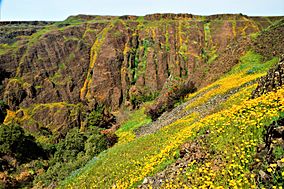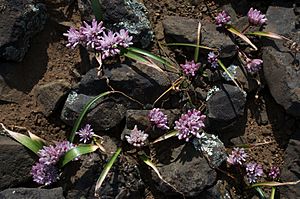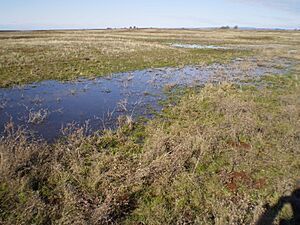North Table Mountain Ecological Reserve facts for kids
Quick facts for kids North Table MountainEcological Reserve |
|
|---|---|
|
IUCN Category IV (Habitat/Species Management Area)
|
|
 |
|
| Location | Butte County, northern California |
| Nearest city | Oroville |
| Area | 3,315 acres (13.42 km2) |
| Established | August 23, 1993 |
| Governing body | California Department of Fish and Wildlife |
The North Table Mountain Ecological Reserve is a special nature area in northern California. It covers about 3,315 acres (which is about 13.4 square kilometers). This reserve is located near the city of Oroville in Butte County. The state of California bought this land in 1993 to protect its unique plants and animals.
What Makes North Table Mountain Special?
This reserve helps protect a very rare type of habitat called Northern Basalt Flow Vernal Pools. These are special ponds that fill up with water only during the rainy season. They are home to many sensitive plants and animals. Some of these species are found only in this area or only in California. This type of vernal pool habitat exists in only four places in the entire state.
The land here is a volcanic plateau, which means it's a flat area formed by ancient lava flows. Over a long time, natural forces like wind and water have split this plateau into two parts: North and South Table Mountain. You can also find smaller valleys, called ravines, with different kinds of trees. The flat top areas are mostly grasslands with rocks covered in lichen, which is like a mossy growth.
When it rains in winter and spring, the vernal pools fill up. The water also creates beautiful waterfalls and makes the wildflowers bloom in amazing displays.
Plants and Animals of the Reserve
The North Table Mountain Ecological Reserve is home to many special plants and animals. Some of these are considered sensitive because they are rare or have specific needs.
Here are a few examples of the unique plants and animals you might find:
- Limnanthes floccosa ssp. californica — This is a type of wildflower called Butte County meadowfoam.
- Juncus leiospermus var. leiospermus — This is a small plant known as Red Bluff dwarf rush.
- Phrynosoma coronatumfrontale — This is the California horned lizard, a fascinating reptile.
In the ravines, you can see different kinds of trees. These include native oaks, madrones, California buckeyes, and California bays.
Many birds also live in or visit the reserve. You might spot large birds like golden eagles, turkey vultures, and peregrine falcons. Smaller birds like the canyon wren and meadowlark also make their homes here.

Rules for Visiting North Table Mountain
The California Department of Fish and Wildlife (CDFW) manages the North Table Mountain Ecological Reserve. In 2003, they set up special rules for this area.
These rules help protect the sensitive plants and animals. For example, horses and bicycles are not allowed in the reserve. However, the department can allow cattle to graze here sometimes. They also allow hunting for deer and certain upland game birds during specific times of the year.
Normally, hunting is not allowed in ecological reserves. So, these special rules are important. They help the CDFW decide when public activities like hunting are okay. This way, they can make sure these activities do not harm the protected species and their habitat.




